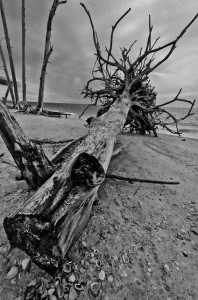
I have had the conversation dozens of time. I'm teaching a workshop when I recommend that one of the students buy a wide-angle lens for landscape photography. The response is classic: “Why do I need a wide angle lens when my kit lens is already an 18mm? Isn't that wide-angle?” The answer isn't just image quality, there's a lot more…
When you take a photo with a wide-angle lens, it makes the viewer feel like he or she is actually standing there. This is difficult to explain in words, but it draws the viewer into the scene. Go on flickr and look at a few photos taken with long telephoto lenses. You may not have noticed it before, but if you pay attention to the photo, you can feel that the camera is not actually 5 feet from the subject, but it is far away and zoomed in. Try it out and you'll see what I mean. This is one of the most important reasons why I recommend wide-angle lenses rather than just having the photographer scoot back a few feet. While the photo on this page isn't a masterpiece, it exemplifies this principle. Look at the very bottom edge. You can tell that you're standing right there and not zoomed way in. Can you feel it?
If you're a technically-minded person and want to know WHY it makes the viewer feel like the viewer is present when looking at a wide-angle shot, then consider the fact that wide-angle lenses make close objects look extremely large and distant objects look quite small. For a more detailed explanation of this principle, check out this great article from lensrentals.com, which I think explains it well.
Next, there is a huge difference between 18mm and 10mm. You may think that, because only a sliver of the photo is cut off when you zoom from 200 – 208mm, the same must be true for wide-angle lenses. You'd be wrong again. Millimeter lens distances work in reverse exponentials, so there is a huge difference between a 10mm and an 18mm lens, but not as big of a difference between a 100mm and a 108mm lens.
Third, wide-angle lenses give a greater depth-of-field than telephoto lenses. In addition to using high aperture values, a wide-angle will ensure that the whole landscape is in sharp focus.
These are three of the most important reasons why a wide-angle lens is well worth the cost for landscape photographers. If you are interested in buying a wide-angle lens for your landscape photography, then you need to know that, unlike most lenses, you need to buy one specific to your camera type. On a full-frame camera, a 20mm lens is considered wide-angle because there is no crop factor on the camera; however, on a consumer-level DSLR (this includes ALL DSLRs which cost less than $1,600 body only), there is a built-in crop factor, so a 20mm lens on a crop factor camera won't be a wide-angle.
Recommended wide-angle landscape lens for a Canon crop DSLR (such as all the canon rebels): Canon 10-22mm lens for around $800.
Recommended wide-angle landscape lens for a Nikon crop DSLR (any Nikon under $1,600 body only): Nikon 10-24mm for around $850.

Hi, after reading article i have two questions :
– Do we really need zoom on wide angle lens ?
– I bought Rokinon 12mm F2.0 for my Sony a6300 with crop factor 1.5. I didn’t see much of the effect like on your example picture with the tree. Is my lens not wide enough ?
Thank you, who will answer my questions
Pingback: cheap 10mm lens - chip seller all play baazar diwali wallpapers Search google
Bill
I was on a trip a few weeks ago. I took several landscape pictures. I was using a 28mm to 70mm zoom lens. many times I felt that I could not get far enough away from my landscape to get it all in the picture. (Nikon D50 ) I know that is old but has the same crop factor as the D7000.
I came up with a creative solution. I took out my Iphone 6 and shot the picture. It captured a mush wider landscape.
I guess it has a built with a wide angle lens.
For some pictures that I could see for a very long way both left and right. I put the IPhone in the panoramic mode.
The down side to that is when looking at the photos there is so much in the photo that you can miss some of the detail.
play around with that and you might be surprised.
think it is best i love them but what you think about this matter
Hi Josh…. nice post. In regards of versatility and equipment, what would you suggest to get a full frame camera body or to get an aps-c body and buy wide angle lenses to contrarest out that lost of the image?
Many thanks…
Very good article about photography.
Pingback: . Unit 6 Practical Skills for Moving Image Production. – . Nadia . mahamud .
Hi- thank you!
I understand a lot more of the basics now. My question is;
Is there a difference in quality of the photo of a wide angle lense on a Full Frame camera vs. a wide angle on a crop sensor camera? (With same field of view.)
(After researching for 3 months, still trying to decide which camera to buy, haha. )
Thank you!
Jeani.